MicMac (Mi’kmaq)
Literature
Native American Lore
The Micmac Indians of northeast North America are thought to have been the first native American society to encounter Europeans–the Norse VIKINGS who arrived about AD 1000. After John Cabot’s visit in 1497, European fishermen and explorers regularly visited Micmac territory, which stretched from New Brunswick and Nova Scotia to Newfoundland.
The Micmac speak an Algonquian language most closely related to CREE, but their closest political and social relations are with the ABNAKI. As expert canoeists and sea navigators, they base their economy on the resources of the sea and its inlets, supplemented by hunting and collecting of plant foods. The Micmac became the first Indians to serve as middlemen in the European fur trade with interior tribes of North America. Missionized by the French in the early 1600s, they remained steadfastly loyal to France for a full generation after the British conquest of 1760. Contemporary Micmac communities are located in much the same territory they occupied five centuries ago. In the late 1980s their population was more than 15,000.

Stories
Rabbit and Otter, The Bungling Host
Many native American tribes have legends in which various animals display their ways and means of obtaining food from others, sometimes using trickster methods. They return meal invitations and even attempt to provide food of a similar nature and in the manner of the previous host. Sometimes, this leads to trouble.
There were two wigwams. Otter lived in one with his grandmother, and Rabbit lived with his grandmother in the other. One day Rabbit started out and wandered over to visit Otter in his camp. When Rabbit entered Otter’s wigwam, Otter asked if he had anything to eat at home. “No,” replied Rabbit. So Otter asked his grandmother if she would cook something for Rabbit, but she told him she had nothing to cook.
So Otter went out to the pond directly in front of his camp, jumped in, and caught a nice long string of eels. Meanwhile, Rabbit was looking to see how Otter would catch his food. With Otter’s great success, Rabbit thought he could do the same.
Rabbit then invited Otter to come over to his camp the next day. His grandmother had already told him that she had nothing to cook for their meal, but asked him to go out and find something. Then Rabbit went out to the same pond where Otter had found the string of eels; but he could get nothing, not one fish, as he could not dive no matter how hard he tried.
In the meantime, his grandmother was waiting. She sent Otter out to find Rabbit, who searched and finally found him at the same pond, soaked and with nothing to show for his efforts.
“What’s the matter with you?” he asked.
“I’m trying hard to get us some food,” he replied.
So friendly Otter jumped into the pond and again caught a string of fish, this time for Rabbit’s grandmother to cook for their dinner. Then Otter went home.

The next day, Rabbit started out to visit Woodpecker. When he reached Woodpecker’s wigwam, Rabbit found him at home with his grandmother. She got out her large pot to cook a meal, but said, “We have nothing to cook in the pot.” So Woodpecker went out front to a dry tree-trunk, from which he picked a quantity of meal. This he took to his grandmother, and she made a good dinner for them.
Rabbit had watched how Woodpecker obtained his meal, so he invited Woodpecker over to visit him. The very next day Woodpecker arrived at Rabbit’s wigwam for a visit. Rabbit asked his grandmother to hang up her pot and cook them some dinner.
“But we have nothing to cook,” she replied. So Rabbit went outside with his birch-bark vessel to fill it with meal. He tried to dig out the meal with his nose, as he had seen Woodpecker do. Soon Woodpecker came out to see what caused the delay.
Poor Rabbit was hurt, with his nose flattened out and split in the middle from trying to break into the wood. Woodpecker left to return to his own wigwam without any dinner. Ever since then, Rabbit has had to carry around his split nose.
Another day, desperate for food, Rabbit thought he would go and steal some of Otter’s eels. He got into the habit of doing this every second night. Toward spring, Otter began to wonder where his eels had gone as his barrel was getting low.
Otter thought he would keep watch and soon found Rabbit’s foot tracks, and said to himself, “For that, I am going to kill Rabbit.” Now Rabbit knew what was going on in Otter’s mind, and when Otter reached Rabbit’s camp, he fled.
Otter asked Rabbit’s grandmother, “Where has Rabbit gone?”
“I don’t know,” she replied. “Last night he brought home some eels, then he went away.”
“He has been stealing my eels,” said Otter. “Now, I’m going to kill him.”
So began Otter’s search for Rabbit, who guessed Otter would be trailing him. Otter began to gain on Rabbit, who picked up a small chip and asked it to become a wigwam. Immediately, the chip became a wigwam and Rabbit became an old man sitting inside.
When Otter came along and saw the wigwam, he also saw the gray- headed old man sitting inside. He pretended to be blind. Otter did not know that this was Rabbit himself. Out of pity for him, Otter gathered some firewood for the old man and asked if he had heard Rabbit passing by. “No, I have not heard any one today.” So Otter continued his search.
Later, Rabbit left his wigwam and started out on another road. Otter could not pick up Rabbit’s trail, so he returned to the wigwam. Not only was it empty, but gone entirely. Only a chip remained in its place.
Otter then saw Rabbit’s tracks where he had jumped out of the wigwam. This trick made Otter very angry and he cried out, “You won’t fool me again.” Otter followed the new trail.
When Rabbit sensed Otter was closing in on him, he picked up another chip and wished it to become a house, and there was the house, ready to live in. Otter came along and was suspicious as soon as he saw the house with a veranda across the front, and a big gentleman walking back and forth all dressed in white, reading a paper.
This, of course, was Rabbit himself, but Otter did not know it. He asked the big gentleman, “Have you seen Rabbit go this way?” The man appeared not to hear. So Otter asked again. The gentleman replied in Pidgin English a phrase that meant, “Never saw Rabbit.” But Otter looked hard at him and noticed the man’s feet, which were Rabbit feet. So Otter felt certain this was his prey.
The big gentleman gave Otter some bread and wine, and Otter left hurriedly to again track Rabbit back to the house. He came to the place, but the house was not there. Otter could see the tracks where Rabbit started running away.
“He’ll never have a chance to trick me again, that’s his last time!” declared Otter.
Rabbit soon came to the head of a bay where there was a very small island, so small that a person could almost jump over it. He jumped onto the island and wished it to become a man-of-war.
Otter came to the same shore and saw the big ship anchored there, and the big gentleman in a white suit walking the deck. Otter called to him, “You can’t trick me now! You’re the man I want.”
Then Otter swam out toward the ship, to board it and to kill Rabbit. But the big gentleman sang out to this sailors, “Shoot him! His skin is worth a lot of money in France.”
This story has been passed down from generation to generation since time immemorial and it explains how Mik’Maq people came into existence in North America. The story tells about the relationship between the Great Spirit Creator and Human Beings and the Environment. It also explains a philosophical view of life which is indigenous to North America. This way of thinking is evident in the Native Languages and Cultures and in the spiritual practices.
The fact that the Mik’Maq people�s language, culture and spiritualism has survived for centuries is based on the creation story. Respect for their elders has given them wisdom about life and the world around them. The strength of their youth has given them the will to survive. The love and trust of their motherhood has given them a special understanding of everyday life.
Among the Mik’Maq people, the number seven is very meaningful. There are seven districts for distinct areas which encompasses an area of land stretching from the Gasp� coast of Quebec and includes New Brunswick, Prince Edward Island and Nova Scotia. The most powerful spirit medicine is made from seven barks and roots. Seven men, representatives from each distinct area or Grand Council District sit inside a sweat-lodge smoke the pipe and burn the sweet grass. Inside the sweat-lodge, the Mik’Maqs will pour water over seven, fourteen and then twenty-one heated rocks to produce hot steam. A cleansing or purification takes place. A symbolic rebirth takes place and the men give thanks to the Spirit Creator, the Sun and the Earth. They also give thanks the first family, Glooscap, Nogami, Netaoansom, and Neganagonimgoosisgo. Listen to the story.
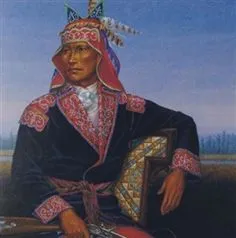
ONE
GISOOLG
Gisoolg is the Great Spirit Creator who is the one who made everything. The work Gisoolg in Mik’Maq means ” you have been created “. It also means ” the one credited for your existence”.
The word does not imply gender. Gisoolg is not a He or a She, it is not important whether the Great Spirit is a He or a She.
The Mik’Maq people do not explain how the Great Spirit came into existence only that Gisoolg is responsible for everything being where it is today. Gisoolg made everything.
TWO
NISGAM
Nisgam is the sun which travels in a circle and owes its existence to isoolg. Nisgam is the giver of life. It is also a giver of light and heat.
The Mik’Maq people believe that Nisgam is responsible for the creation of the people on earth. Nisgam is Gisoolg�s helper. The power of Nisgam is held with much respect among the Mik’Maq and other aboriginal peoples. Nisgam owes its existence to Gisoolg the Great Spirit Creator.
THREE
OOTSITGAMOO
Ootsitgamoo is the earth or area of land upon which the Mik’Maq people walk and share its abundant resources with the animals and plants. In the Mik’Maq language Oetsgitpogooin means “the person or individual who stand upon this surface”, or “the one who is given life upon this surface of land”. Ootsitgamoo refers to the Mik’Maq world which encompasses all the area where the Mik’Maq people can travel or have travelled upon.
Ootsitgamoo was created by Gisoolg and was placed in the centre of the circular path of Nisgam, the sun. Nisgam was given the responsibility of watching over the Mik’Maq world or Ootsitgamoo. Nisgam shines bright light upon Oositgamoo as it passes around and this brought the days and nights.
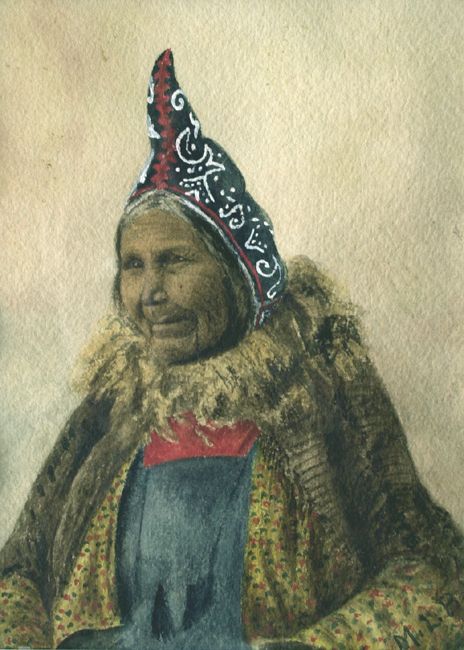
FOUR
GLOOSCAP
After the Mik’Maq world was created and after the animals, birds and plants were placed on the surface, Gisoolg caused a bolt of lightening to hit the surface of Ootsitgamoo. This bolt of lightning caused the formation of an image of a human body shaped out of sand. It was Glooscap who was first shaped out of the basic element of the Mik’Maq world, sand.
Gisoolg unleashed another bolt of lightening which gave life to Glooscap but yet he could not move. He was stuck to the ground only to watch the world go by and Nisgam travel across the sky everyday. Glooscap watched the animals, the birds and the plants grow and pass around him. He asked Nisgam to give him freedom to move about the Mik’Maq world.
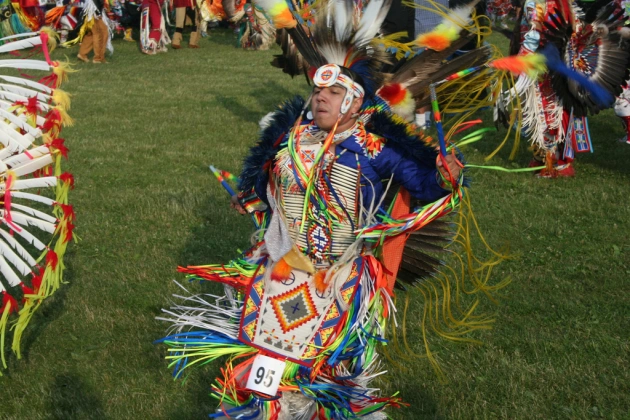
While Glooscap was still unable to move, he was lying on his back. His head was facing the direction of the rising sun, east, Oetjgoabaniag or Oetjibanoog. In Mik’Maq these words mean “where the sun comes up ” and “where the summer weather comes from” respectively. His feet were in the direction of the setting sun or Oetgatsenoog. Other Mik’Maq words for the west are Oeloesenoog, “where the sun settles into a hallow” or Etgesnoog “where the cold winds come from”. Glooscap�s right hand was pointed in the direction of the north or Oatnoog. His left hand was in the direction of the south or Opgoetasnoog. So it was the third big blast of lightening that caused Glooscap to become free and to be able to stand on the surface of the earth.
After Glooscap stood up on his feet, he turned around in a full circle seven times. He then looked toward the sky and gave thanks to Gisoolg for giving him life. He looked down to the earth or the ground and gave thanks to Ootsigamoo for offering its sand for Glooscap’s creation. He looked within himself and gave thanks to Nisgam for giving him his soul and spirit.
Glooscap then gave thanks to the four directions east, north, west and south. In all he gave his heartfelt thanks to the seven directions.
Glooscap then travelled to the direction of the setting sun until he came to the ocean. He then went south until the land narrowed and he came to the ocean. He then went south until the land narrowed and he could see two oceans on either side. He again travelled back to where he started from and continued towards the north to the land of ice and snow. Later he came back to the east where he decided to stay. It is where he came into existence. He again watched the animals, the birds and the plants. He watched the water and the sky. Gisoolg taught him to watch and learn about the world. Glooscap watched but he could not disturb the world around him. He finally asked Gisoolg and Nisgam, what was the purpose of his existence. He was told that he would meet someone soon.

The Micmac flag is 3 x5 feet and has a red central stripe bracketed by vertical yellow stripes – one-tenth of the width of the red stripe – at each end. In the center of the red stripe is a yellow disk, whose diameter equals one-ninth of the height of the flag and which denotes the continuum, the cycle and fullness of life as viewed by Native tradition. The central disk – representing for the Micmac unity amidst their far-flung diversity – is edged by a wide yellow band and a narrower black outline, the latter defining a circle divided into quarters by diagonal black lines. This apparent division in quarters is superficial, however, because the red, green, yellow, black and blue elements inside the circle are part of a tightly knit and carefully thought-out symbolic structure, as outlined below.
According to Bernard Jerome, the flag dates back to the late 1930s and its colors symbolize Life and Fire (red), Mother Earth, vegetable life and medicinal protection (green), the growing season and the Sun’s heat (yellow), late season or Winter (black), the Sky and Water (blue), and the Supernatural (white). Viewed in the holistic, integrated light that informs most Amerindian symbolism, the colors point to the fullness and cycle of creation, from its beginnings (red) to its mid-day (yellow) and finally to its dormant, wintery stage (black).
The design elements within the center integrate into a stylized view of a wigwam – the traditional domed dwelling of eastern and central Native Americans – both in its past structure (diagonal black lines with black disks representing the entrance) and its modern form (red semicircles within white-contoured yellow structures). Like the balance and continuity of life represented by the colors, the stylized allusions to traditional and modern dwellings bridge the old and the new, the past and present – symbolic of Micmac determination to honor and remember the past without living in it.
Beyond the mere physical access to the wigwam indicated by the black disks, the entrance is also a reminder of the need to journey inside oneself in the search for inner spirituality and to isolate oneself from the world for periods of introspection and meditation.
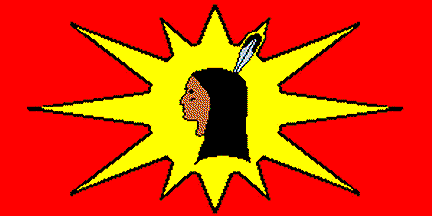
































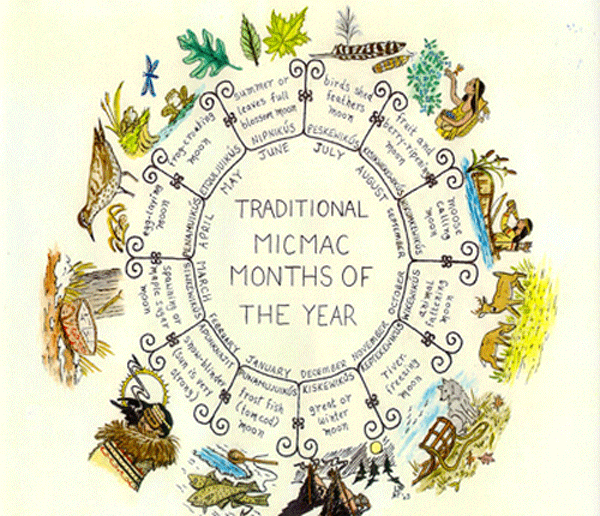

I love reading an article that can make men and women think.
Also, many thanks for allowing for me to comment!
LikeLike